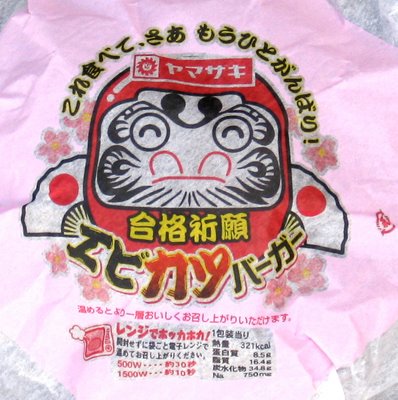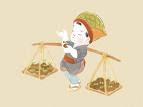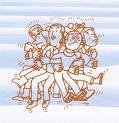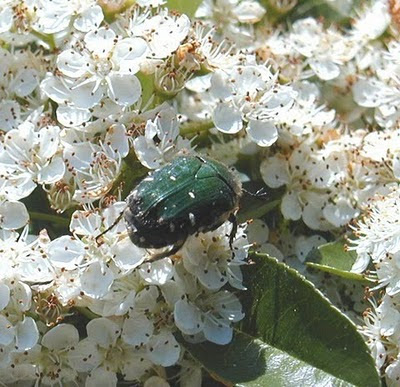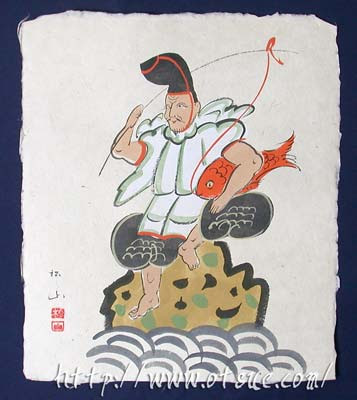[ . BACK to WORLDKIGO TOP . ]
::::::::::::::::::::::::::::::::::::::::::::::::::::::::::::::::::::::::::::::::::::::::::::::::::::
Living at home in all seasons
***** Location: Japan
***** Season: Various, see below
***** Category: Humanity
*****************************
Explanation

The traditional Japanese farmhouse or city home is built with wood, paper, mud walls and a reed roof. So you feel the seasons very strongly.
There is not so much furniture in the traditional home.
It is built for many generations to live together and also provide a space to entertain visitors.
Here are some season words concerned with the various preparations and items used at home to feel comfortable at any time of the year.

:::::::::::::::::::::::::::::::::::::::::::::::::::::::::::::::::::::::::::::::::::::::::::::::::::
SPRING
harudanro 春暖炉 (はるだんろ) heating in spring
..... haru no danro 春の暖炉(はるのだんろ)stove in spring
Heating in winter
harugotatsu 春炬燵 (はるごたつ) kotatsu in spring
..... haru no kotatsu 春の炬燵(はるのこたつ)
..... haru no kotatsu 春の火燵(はるのこたつ)
. KOTATSU in alls seasons
 haru no ro 春の炉 (はるのろ) hearth in spring
haru no ro 春の炉 (はるのろ) hearth in spring
..... haruro, haru-ro 春炉(はるろ)
It is still wellcome to provide warmth in the kitchen. Often this is also a kind of
irori open hearth where the whole family gathers.
harushooji 春障子 (はるしょうじ) sliding doors in spring
..... haru no shooji 春の障子(はるのしょうじ)
The spring sunshine now feels warm through the thin paper panes of the sliding doors. It feels good to enjoy the evening sunshine of the lengthening days.
haru hibachi 春火鉢 (はるひばち) brazier in spring
haru hioke, haru hi-oke
shuntoo 春燈 (しゅんとう) lamplight in spring
..... haru no hi 春の燈(はるのひ)
..... harutomoshi, haru tomoshi 春燈(はるともし)
haru no shoku 春の燭(はるのしょく)candlestick in spring
The soft light adds to the misty nights of spring.
.................................................................................
mid-spring
kitamado hiraku 北窓開く (きたまどひらく) opening the north window
and more
WINDOW kigo for all seasons
mebari hagu 目貼剥ぐ (めばりはぐ ) taking off the window seals
They are made of paper and put on at the beginning of winter.
.................................................................................
late spring
danro osamu 暖炉納む (だんろおさむ) packing the stove away
..... danro hazusu 晩春 暖炉外す(だんろはずす)
..... stoobu nozoku ストープ除く(すとーぶのぞく)
ro fusagi 炉塞 (ろふさぎ) closing the irori open hearth
ro no nagori 炉の名残(ろのなごり)
..... robuta 炉蓋(ろぶた)cover for the irori
Stove in winter
kotatsu 炬燵塞ぐ (こたつふさぐ) packing the kotatsu away
..... kotatsu no nagori) 炬燵の名残(こたつのなごり)
. KOTATSU in alls seasons
shunkyuu 春窮 famine in spring
.................................................................................
.SAIJIKI ... HUMANITY
Kigo for Spring
:::::::::::::::::::::::::::::::::::::::::::::::::::::::::::::::::::::::::::::::::::::::::::::::::::
SUMMER
Blinds, summer curtains (sudare)
Inclucing bamboo blinds, seating mats (goza), rattan chairs (too isu) and a few more summer items for the home.
hiyoke 日除 (ひよけ)
sun shade cover
hiooi, hi ooi 日覆(ひおおい)
similar to a sudare, but made from cotton cloth or other material.
.................................................................................
amido 網戸 (あみど ) screen door
amimado 網窓(あみまど)window screen
amishooji 網障子(あみしょうじ) sliding door screen
. . . CLICK here for Photos !
With so many insects around in summer, these screen protectors are absolutely necessray to keep the home aired, but clean. They are a modern version of the mosquito nets used only during the night in the Edo period.
.................................................................................
barukonii バルコニー balcony
beranda ベランダ veranda
terasu テラス terrace
rodai 露台 (ろだい) terrace
花房の吹かれころべる露台かな
hanafusa no fukare koroberu rodai kana
a bunch of flowers
blown and tumbling down
on the veranda . . .
Sugita Hisajo 杉田久女 (1890-1946)
.................................................................................
. natsu hibachi 夏火鉢(なつひばち) brazier in summer
. natsu noren 夏暖簾 (なつのれん) noren for summer
asa noren 麻暖簾(あさのれん) noren made from hemp cloth
. natsu tomoshi 夏燈 (なつともし) lamplight in summer
..... natsu no hi 夏の燈(なつのひ)
hi suzushi 燈涼し(ひすずし)cool lamp light
natsu yakata 夏館 (なつやかた) home in summer
.... natsu yashiki 夏邸(なつやしき)
natsu no yado 夏の宿(なつのやど) lodging in summer
living at home in summer, many more KIGO
. natsu zashiki 夏座敷 sitting room in summer
MORE summer appliances are to be found here
.SAIJIKI ... HUMANITY
Kigo for Summer
:::::::::::::::::::::::::::::::::::::::::::::::::::::::::::::::::::::::::::::::::::::::::::::::::::
AUTUMN
Autumn in your home ...
KIGO LIST
:::::::::::::::::::::::::::::::::::::::::::::::::::::::::::::::::::::::::::::::::::::::::::::::::::
WINTER
fuyuzashiki 冬座敷 (ふゆざしき)
Japanese living room in winter
Things to keep the house warm
KIGO LIST
:::::::::::::::::::::::::::::::::::::::::::::::::::::::::::::::::::::::::::::::::::::::::::::::::::
NEW YEAR
New Year Decorations
hakizome 掃初 (はきぞめ)
first cleaning the home
Cleaning the home, broom and more Japan
 *****************************
Worldwide use
*****************************
*****************************
Worldwide use
*****************************
Things found on the way

yarido 遣り戸, 鑓戸, 槍戸
sliding door made of wood, at the outside of a home or estate
nowadays an amado 雨戸 "rain door"
made of wood or now of metal or plastic.
yaridoguchi 遣り戸口 entrance/exit with a yarido
first used in the Heian period
Many merchant houses could close with a large wooden shutter at night and keep a small
yarido for business at night.
kamoi 鴨居 a narrow piece of wood that passes over the sliding doors and around an entire Japanese room.
秋風の鑓戸の口やとがり声
akikaze no yarido no kuchi ya togarigoe
autumn wind
through the opening of the sliding door -
this piercing sound
Tr. Gabi Greve
Written in寛文7年, Basho age 24
This is a pun with the sound
YARI, which can also mean a spear 槍, piercing through the door to hit an enemy.
. Matsuo Basho 松尾芭蕉 - Archives of the WKD .
:::::::::::::::::::::::::::::::::::::::::::::::::::::::::::::::::::::::::::::::::::::::::::::::::::::::
. buke yashiki 武家屋敷 Samurai Residence .
genkan 玄関 entrance hall
. hisashi 廂 - 庇 eaves, canopy .
kobisashi 小庇 small caonpy
machiya 町屋
"city house" in Kyoto
. mado 窓 window .
. Mon 門 (kado) gate, entrance .
nooka 農家
farmhouse, Bauernhaus
. Ranma 欄間 transom .
shooka 商家
merchant house
. yajiri 屋尻 back of a farmhouse .
- yane 屋根 roof -
 quote
Nihon Minkaen Kawasaki
quote
Nihon Minkaen Kawasaki 日本民家園
Minkaen is a splendid Open-Air Folk House Museum in Japan, located in Kawasaki city,adjacent to Metropolitan Tokyo. It is known for the remarkable collection of old Japanese folk houses, such as farms and merchant houses. Many of them are the important cultural properties of Japan. The essence of traditional Japanese architecture, beauty and functionality, are well reflected even in Japanese folk houses.
To conserve these valuable historic buildings from the past, the city of Kawasaki began to re-erect original buildings of Edo period in Minkaen.
source : www.city.kawasaki.jp
*****************************
HAIKU
. WKD : Kobayashi Issa 小林一茶 in Edo .
how uneasy and tense you must feel in a house built on rock
雪散るやきのふは見へぬ借家札
yuki chiru ya kinoo wa mienu shakuya-fuda
scattering snowflakes
new sign up today --
house for rent
Tr. Chris Drake
This hokku is from the 9th month (October) of 1813, the year Issa finally returned to live in his hometown. It's in Issa's collected works 3.173. In a posthumous collection published by Issa's students in 1829, the short headnote by Issa translated above is placed before the hokku.
The house must be built on an outcropping of bedrock, and the idea of not living directly on the earth seems strange to Issa. I don't know whether Issa was familiar with Feng shui (Japanese Fuusui) geomancy or not, but he did study the Chinese classics to a certain extent. In any case, he feels the present owner must be leaving because of anxiety and stress caused by his/her inability to live in direct contact with the soil. It is still autumn, but light snow has already begun to come down in Issa's hometown and the area around it in the snow country. Scattered snowflakes fall here and there on the rock beneath the house, and it's unlikely anyone will rent the house in the cold, snowy months ahead. The location of the house and ominous timing of the sign together suggest the house will probably remain empty for quite a while.
In the following month, the 10th month (November), Issa revised the hokku a little (collected works 3.269):
yuki chiru ya kinoo wa mienu akiya-fuda
scattering snowflakes
new sign up today --
empty house
By then it must have been obvious no one was interested in renting it for the winter.
Chris Drake
..........................................................................
a blessing for your new house --
年立や雨おちの石凹む迄
toshi tatsu ya ama-ochi no ishi hekomu made
may many years come --
until the rain-drip stones
are hollowed out
Tr. Chris Drake
This hokku is from the 9th month (October) of 1822, though Issa indicates by putting the character for 'spring' above it in his diary that it is intended to be formally read again at New Year's, three months later. Perhaps the new house is scheduled to be finished by New Year's. For part of the 9th month Issa was visiting students who lived near his hometown, so one of them may be building a new house, as indicated by the headnote.
Traditional Japanese houses and buildings didn't use gutters. Instead, they used rows of cut stone that ran along the ground below the edges of the eaves. Smaller houses tended to use single rows of stone, while temples, mansions, and larger structures often used two rows of cut stone with a zone running between them filled with small stones or large gravel. Rain spilling down from the eaves fell onto these rain-drip stones and was drained off. Without the stones, rain would erode the ground beneath, forming troughs under the eaves. Of course the stones themselves will be very gradually worn down in the middle by dripping raindrops, but they normally last several decades.

Issa's hokku blessing gains power from it obliqueness. A few wealthy farmers used drip-stones beneath their thatched roofs, but the stones were more common below the eaves of town houses with tile roofs, so probably this is a tile-roof house with at least one row of cut stones running around it. Instead of praising the new house's appearance, however, Issa makes an understated prayer that the almost invisible rain-drip stones last many decades. Long-lived wood houses were not common in Japan's wet climate without extensive upkeep, so Issa's prayer is very appropriate.
Eventually the stones will be worn down or hollowed out in the places where the most drops fall, but they are one of the most reliable and durable parts of the house. Though easily overlooked, they are able to suggest the whole house and even the lifespan of the owner, while rain suggests the problems and difficulties the owner will probably face in his life, so the enduring drip-stones will be an important support for him in the future. I imagine the owner of the house -- Issa's student and patron? -- was very glad to get this hokku, whose power stands behind its prayer.

This photo shows the rain-drip stones under the eaves of the Ryoanji Rinzai zen temple in Kyoto. The stones also go around the amazing rock garden directly under the eaves of the small roofs protecting the garden walls. I have to admit that when I went to Ryoanji I was so overwhelmed by the garden I didn't even notice the rain-drip stones. Thank you, Issa, for enlarging my consciousness!
Chris Drake
::::::::::::::::::::::::::::::::::::::::::::::::::::::::::::::::::::::::::::::::::::::::::::::::::::
過去がすぐ暗がりとなる春障子
kako ga sugu kuragari to naru haru shooji
the past
soon becomes darkness -
sliding doors in spring
Kaneko Shin 金子晋 (1932 - )
*****************************
Related words
*****
Homeland, Hometown (furusato) Japan
Heimat, Fatherland, Motherland
. HUMANITY KIGO
for all seasons
*****
Thatched Hut(iori) )
an 庵 hermitage, hut, yado 宿 my home
Bashoo an 芭蕉庵 at Fukagawa
. Matsuo Basho 松尾芭蕉 - Archives of the WKD .
:::::::::::::::::::::::::::::::::::::::::::::::::::::::::::::::::::::::::::::::::::::::::::::::::::::
[ . BACK to DARUMA MUSEUM TOP . ]
[ . BACK to WORLDKIGO . TOP . ]
:::::::::::::::::::::::::::::::::::::::::::::::::::::::::::::::::::::::::::::::::::::::::::::::::::::

